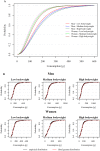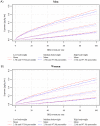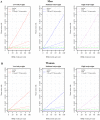Probabilistic approach for assessing cancer risk due to benzo[a]pyrene in barbecued meat: Informing advice for population groups
- PMID: 30408084
- PMCID: PMC6224084
- DOI: 10.1371/journal.pone.0207032
Probabilistic approach for assessing cancer risk due to benzo[a]pyrene in barbecued meat: Informing advice for population groups
Abstract
Background: Consumption of meat prepared by barbecuing is associated with risk of cancer due to formation of carcinogenic compounds including benzo[a]pyrene (BaP). Assessment of a population's risk of disease and people's individual probability of disease given specific consumer attributes may direct food safety strategies to where impact on public health is largest. The aim of this study was to propose a model that estimates the risk of cancer caused by exposure to BaP from barbecued meat in Denmark, and to estimate the probability of developing cancer in subgroups of the population given different barbecuing frequencies.
Methods: We developed probabilistic models applying two dimensional Monte Carlo simulation to take into account the variation in exposure given age and sex and in the individuals' sensitivity to develop cancer after exposure to BaP, and the uncertainty in the dose response model. We used the Danish dietary consumption survey, monitoring data of chemical concentrations, data on consumer behavior of frequency of barbecuing, and animal dose response data.
Findings: We estimated an average extra lifetime risk of cancer due to BaP from barbecued meat of 6.8 × 10-5 (95% uncertainty interval 2.6 × 10-7 - 7.0 × 10-4) in the Danish population. This corresponds to approximately one to 4,074 extra cancer cases over a lifetime, reflecting wide uncertainty. The impact per barbecuing event on the risk of cancer for men and women of low body weight was higher compared to higher bodyweight. However, the difference due to sex and bodyweight between subgroups are dwarfed by the uncertainty.
Interpretation: This study proposes a model that can be applied to other substances and routes of exposure, and allows for deriving the change in risk following a specific change in behaviour. The presented methodology can serve as a valuable tool for risk management, allowing for the formulation of behaviour advice targeted to specific sub-groups in the population.
Conflict of interest statement
The authors have declared that no competing interests exist.
Figures







Similar articles
-
Analysis of 200 food items for benzo[a]pyrene and estimation of its intake in an epidemiologic study.Food Chem Toxicol. 2001 May;39(5):423-36. doi: 10.1016/s0278-6915(00)00158-7. Food Chem Toxicol. 2001. PMID: 11313108
-
Excretion kinetics of urinary 3-hydroxybenzo[a]pyrene following dietary exposure to benzo[a]pyrene in humans.Arch Toxicol. 2012 Jan;86(1):45-53. doi: 10.1007/s00204-011-0727-9. Epub 2011 Jul 22. Arch Toxicol. 2012. PMID: 21785897 Clinical Trial.
-
Benzo(a)pyrene modulates fluoranthene-induced cellular responses in HT-29 colon cells in a dual exposure system.Environ Toxicol Pharmacol. 2013 Sep;36(2):358-367. doi: 10.1016/j.etap.2013.04.017. Epub 2013 May 10. Environ Toxicol Pharmacol. 2013. PMID: 23732482 Free PMC article.
-
Formation and mitigation of PAHs in barbecued meat - a review.Crit Rev Food Sci Nutr. 2022;62(13):3553-3568. doi: 10.1080/10408398.2020.1867056. Epub 2021 Jan 7. Crit Rev Food Sci Nutr. 2022. PMID: 33412921 Review.
-
Application of the margin-of-exposure (MoE) approach to substances in food that are genotoxic and carcinogenic e.g.: benzo[a]pyrene and polycyclic aromatic hydrocarbons.Food Chem Toxicol. 2010 Jan;48 Suppl 1:S42-8. doi: 10.1016/j.fct.2009.09.039. Epub 2009 Oct 8. Food Chem Toxicol. 2010. PMID: 19818825 Review.
Cited by
-
Saliva as a diagnostic tool to measure polycyclic aromatic hydrocarbon exposure in dental patients exposed to intimate partner violence (IPV).Biomed J. 2023 Dec;46(6):100586. doi: 10.1016/j.bj.2023.02.006. Epub 2023 Feb 18. Biomed J. 2023. PMID: 36804615 Free PMC article.
-
A new approach for reducing pollutants level: a longitudinal cohort study of physical exercises in young people.BMC Public Health. 2022 Feb 3;22(1):223. doi: 10.1186/s12889-022-12621-2. BMC Public Health. 2022. PMID: 35114971 Free PMC article.
References
-
- Duedahl-Olesen L, Aaslyng M, Meinert L, Christensen T, Jensen AH, Binderup ML. Polycyclic aromatic hydrocarbons (PAH) in Danish barbecued meat. Food Control. 2015;57:169–176. 10.1016/j.foodcont.2015.04.012 - DOI
-
- Scientific Committee on Food. Opinion of the Scientific Committee on Food on the risk to human health of Polycyclic Aromatic Hydrocarbons in food. European Commission Health and Consumer Protection Directorate-General SCF/CS/CNTM/PAH/29 Final; 2002. Available from: https://ec.europa.eu/food/sites/food/files/safety/docs/sci-com_scf_out15....
MeSH terms
Substances
LinkOut - more resources
Full Text Sources

